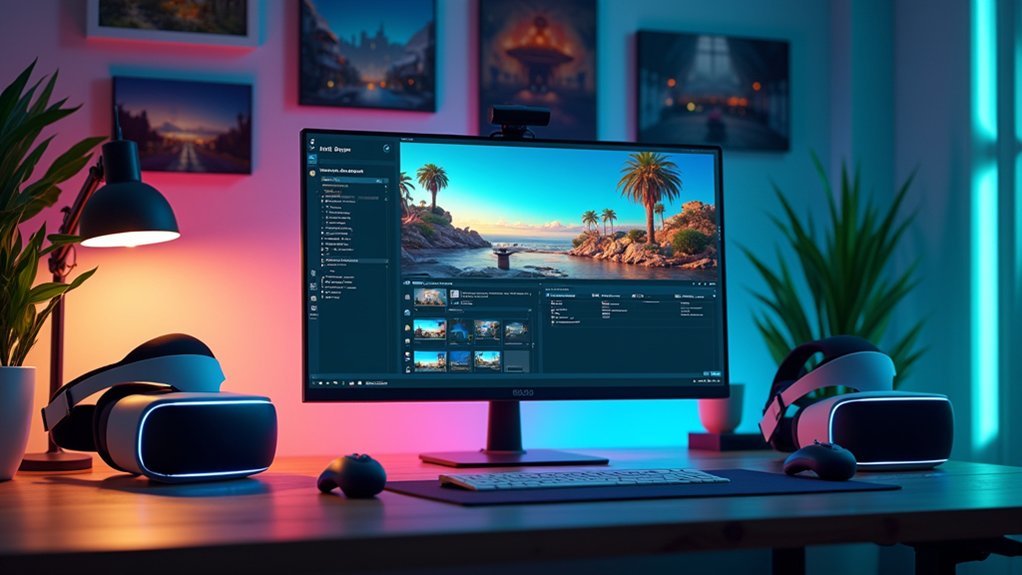You’ll want to contemplate Unity XR Interaction Toolkit for cross-platform development, Microsoft’s MRTK for enterprise-grade applications with advanced spatial interactions, and Oculus Integration SDK for Meta device optimization. VRTK transforms rapid prototyping with reusable components, reducing development time from weeks to hours. Extended Reality Toolkit excels at lightweight, cross-platform solutions with robust hand tracking capabilities. These frameworks can cut your VR development timeline by up to 70% while ensuring seamless enterprise deployment across multiple platforms and devices.
Unity XR Interaction Toolkit for Cross-Platform Development

When you’re developing VR applications for multiple platforms, Unity’s XR Interaction Toolkit streamlines the entire process by providing a unified framework that works seamlessly across Oculus, HTC Vive, and other major XR platforms.
You’ll gain access to thorough development tools that include controller support, physics interactions, and locomotion systems, enabling you to create immersive content without rebuilding core functionality for each device.
The toolkit’s compatibility with existing Unity assets means you can integrate it into current projects efficiently.
Developers benefit from extensive documentation and community support that accelerate learning curves and troubleshooting.
Regular updates guarantee you’re working with cutting-edge features while maintaining cross-platform consistency for professional VR experiences.
Microsoft Mixed Reality Toolkit (MRTK) for Enterprise Applications
Since Microsoft designed the Mixed Reality Toolkit (MRTK) specifically for enterprise-grade applications, you’ll find it delivers the advanced spatial interactions capabilities that professional environments demand.
This open-source project enables you to build cross-platform applications extending beyond HoloLens to various mixed reality devices.
You’ll leverage thorough hand tracking and voice commands features that create intuitive user experiences essential for enterprise applications. The toolkit’s robust sample scenes and documentation support rapid prototyping, letting you deploy solutions quickly across healthcare, manufacturing, and education sectors.
MRTK’s scalability makes it ideal for immersive training and collaborative environments. As an open-source project, you’ll benefit from continuous community contributions that guarantee the platform evolves with your enterprise needs while maintaining flexibility across diverse industry applications.
Oculus Integration SDK for Meta Device Optimization

While enterprise VR development demands platform-specific optimization, you’ll find the Oculus Integration SDK delivers precisely that for Meta’s ecosystem of devices.
You’ll access advanced features like hand tracking and passthrough capabilities that enable sophisticated immersive applications for business use cases.
The SDK seamlessly integrates with Unity and Unreal Engine, streamlining your development workflow while providing thorough documentation and sample projects.
You’ll benefit from regular updates that maintain compatibility with Meta devices as new capabilities emerge.
Most importantly, you’ll achieve cross-platform compatibility through OpenXR integration, future-proofing your enterprise VR investments.
This guarantees your applications remain viable across different platforms while maximizing the specialized features that Meta devices offer for professional environments.
Virtual Reality Toolkit (VRTK) for Rapid Prototyping
Beyond platform-specific optimization, you’ll need tools that accelerate your development timeline across multiple VR platforms. Virtual Reality Toolkit (VRTK) for Unity transforms rapid prototyping by providing reusable components that handle complex interaction types like grabbing, teleportation, and button presses without extensive coding.
| Traditional VR Development | VRTK Rapid Prototyping |
|---|---|
| Weeks of custom scripting | Hours with pre-built components |
| Complex interaction programming | Drag-and-drop low-code solutions |
| Limited community resources | Active support network |
You’ll leverage VRTK’s beginner-friendly framework to create immersive experiences quickly, regardless of your programming expertise. The toolkit’s continuous updates guarantee compatibility with emerging technologies, while robust community support provides tutorials and documentation. For developers seeking efficient VR prototyping workflows, VRTK delivers the speed and flexibility essential for enterprise projects.
Extended Reality Toolkit (XRTK) for Lightweight Enterprise Solutions

When enterprise projects demand streamlined development without sacrificing functionality, Extended Reality Toolkit (XRTK) delivers a community-supported framework that prioritizes lightweight architecture and cross-platform compatibility.
You’ll find this extended reality toolkit excels at creating cross-platform XR applications with robust hand tracking and UI capabilities that enable intuitive user interactions for non-gaming enterprise applications.
The framework’s seamless integration with major development engines like Unity enhances your development workflow efficiency. Its modular design lets you customize functionalities to match specific enterprise use cases, providing flexibility without bloat.
You’re also supported by an active community that drives ongoing improvements and shares valuable resources, ensuring you have access to cutting-edge advancements while maintaining the lightweight framework’s core benefits.
Frequently Asked Questions
What Are the Typical Licensing Costs for Enterprise VR SDK Solutions?
You’ll find enterprise VR SDK licensing costs vary considerably, ranging from free open-source options to $10,000+ annually for premium solutions. Pricing typically depends on features, support levels, and your company’s size.
How Do These SDKS Handle Data Security and Privacy Compliance Requirements?
You’ll find these SDKs implement encryption protocols, access controls, and audit trails. They’re designed to meet GDPR, HIPAA, and SOC 2 standards through data anonymization, secure storage, and configurable privacy settings.
What Level of Technical Expertise Is Required to Implement These Solutions?
You’ll need intermediate to advanced programming skills, depending on the SDK’s complexity. Most require familiarity with C#, C++, or JavaScript, plus 3D development experience and understanding of VR concepts like spatial tracking.
Which Industries Benefit Most From Enterprise VR SDK Implementations?
You’ll find healthcare leads adoption for surgical training and patient therapy. Manufacturing uses VR for equipment training and prototyping. Education transforms learning experiences. Real estate creates virtual property tours. Automotive designs vehicles virtually.
How Do Performance Requirements Differ Between Consumer and Enterprise VR Applications?
You’ll find enterprise VR demands higher frame rates, lower latency, and extended session stability compared to consumer apps. You’re dealing with mission-critical workflows requiring consistent performance over hours, not casual gaming sessions.





Leave a Reply